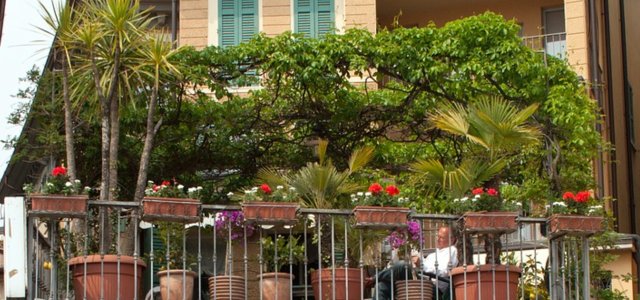
A balcony garden is not only beautiful to the eye, but can also help provide herbs, fruits and vegetables. Here you will learn how to create a balcony garden.
A balcony garden can become a true oasis of tranquility, but also a practical spot for self-sufficiency in food. You can design your balcony garden according to your preferences and needs.
If you have little experience with gardening, we recommend you start small first. In this article you will learn how to create a balcony garden, which plants are suitable and how to take care of them.
Contents
- 1 Preparations for the balcony garden
- 2 The orientation of the balcony
- 3 The right tool for the balcony garden
- 4 The right planters for the balcony garden
- 5 The right size of the planter
- 6 How to plant the balcony garden
- 7 Planting flowers for the balcony garden
- 8 Herbs for the balcony garden
- 9 Balcony garden fruit
- 10 Vegetables for the balcony garden
- 11 Lettuce for the balcony garden
- 12 Maintain balcony garden
- 13 Balcony garden winter
- 14 Author
Preparations for the balcony garden
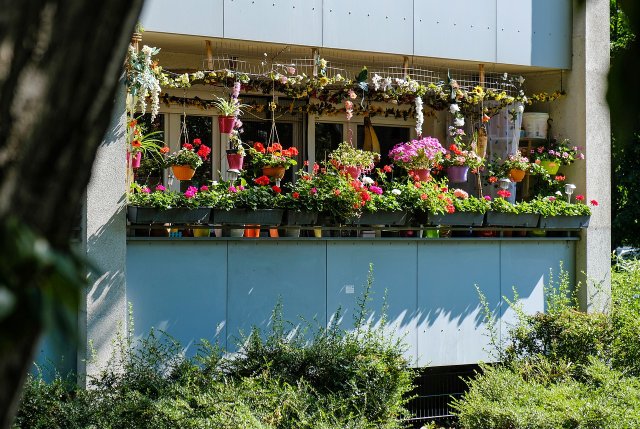
If you want to turn your balcony into a garden, it is very important that you realize a few points beforehand. Therefore, before working on the balcony garden comes planning.
A few considerations about the size of the balcony
Even on the smallest balcony you can plant flowers or vegetables. However, before you do this, be sure to ask yourself a few questions.
- How big is the balcony?
- What part of the balcony do you want to use as a garden (railing, wall, floor area)?
- What else do you want to use the balcony for?
- Do you want to have a sitting area on the balcony?
- Do you need the balcony to dry the laundry?
The orientation of the balcony
In addition to the size of the balcony, the location to the sun is an important factor when creating the balcony garden.
- North – shady, cool
- East – morning sun
- South – midday sun, sunny, warm
- West – sunny, relatively windy
Depending on the balcony orientation, different plants are suitable for the balcony garden. While tomatoes or other plants for full sun love the hot south balcony, other plants also need shade from time to time.
Time spent
Depending on how much time you want to spend on your balcony, you should design the balcony garden differently.
Two to three balcony boxes on the balcony railing require little maintenance.
If you have a lot of small herb pots on your balcony, additional hanging baskets hanging from the ceiling and lettuce growing in the balcony box, you need to plan at least half an hour for daily care.
Watering
The more plants you want to grow on your balcony, the more water you will need to water them. The path from the water to the balcony should therefore also be included in your considerations when planning a balcony garden.
Shading of the balcony
If your balcony is south-facing, you may have an awning to shade the balcony and especially the room. However, vegetables and Mediterranean plants need as much sun as possible and don’t thrive as well under the protection of the awning. In that case, a few window boxes in front of the balcony may be a better choice.
The right soil
Depending on the type of plant, you will need different soil. If you want to avoid plastic packaging, look for unpackaged soil in your area. Often you can get loose soil at the recycling center and transport it home in your own containers.
The right tool for the balcony garden
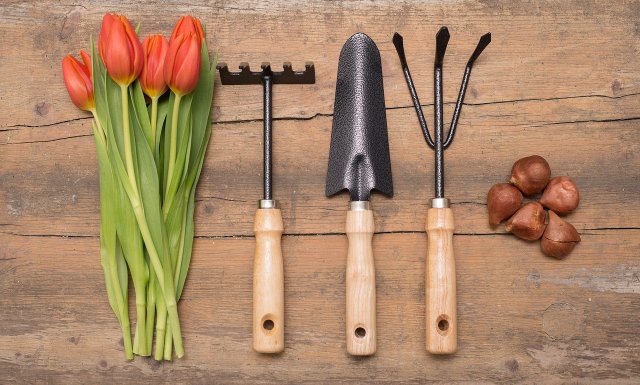
You only need a few tools to get started with your balcony garden. In stores you can get suitable hand tools, which are more suitable for working with pots, balcony boxes and in the raised bed than the large garden tools.
These are the garden tools you should purchase if you want to start a balcony garden:
- a small shovel to transfer soil
- a small narrow shovel for planting plants
- a good pair of secateurs
- a small and a medium watering can with a detachable sprayer.
Depending on how extensive your balcony garden project turns out to be, a rake may also be helpful.
The right planters for the balcony garden
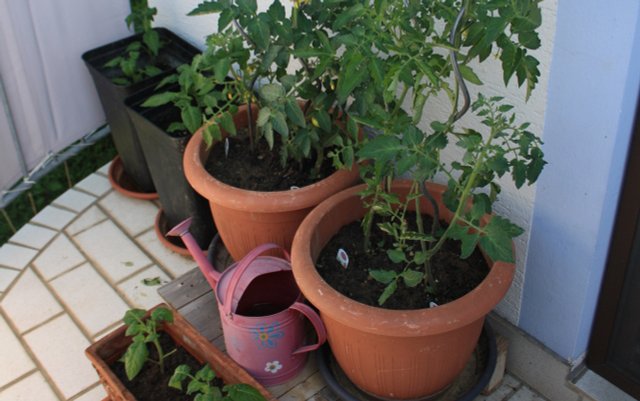
Different plants have different space requirements. Depending on what plants you want to grow in your balcony garden, you’ll need different planters.
Material considerations
Planters are made of different materials: plastic, wood, terracotta or ceramic. Each material has different properties.
Plastic planters are very lightweight and therefore very popular. Pots made of terracotta look pretty, store moisture that they can later release and balance the temperature. However, terracotta is very heavy and not so suitable for large planters on the balcony. With wooden planters, the material weathers quickly and is not as durable. Ceramic is not frost resistant and therefore not suitable for winter.
The right size of the planter
In addition to appearance and material, the right size plays a crucial role. In order for the plant to develop well and healthy, the entire root area must comfortably fit in the vessel.
Different types of planters
- Balcony box for the balcony railing
- hanging baskets for hanging plants
- Pots and bowls of different sizes
- Baskets and other creative planters
Make sure that each pot has a matching trivet. The saucer will catch the excess water from watering. This way, on the one hand, your balcony will not be polluted, but on the other hand, the roots of the plant will have the opportunity to absorb the water at a later time and you will not have to water it so often. Also, excess water can run off, which prevents waterlogging.
How to plant the balcony garden

If you want to plant your balcony for the first time, it is best to use pre-pulled plants. This way you will have a quicker success.
How to plant your planter
- Cover the holes in the planter with potsherds or stones. This is important to prevent the soil from clogging the drainage.
- Fill the balcony box or pot a few inches with soil.
- Remove the pot from the pre-pulled plant.
- Place the plant in the planter. The top of the soil ball should be about two to three inches below the rim.
- Fill the spaces in between with soil.
- Press the soil in the spaces firmly with your hands.
- Add more soil if necessary. The soil should reach the top of the plant’s soil ball. Leave a watering margin of at least two to three inches.
- Water the newly repotted plant well.
Tips for planting
Plant balcony planters best in the late afternoon when the sun is not so hot.
Place the planter in the shade for one to three days until the plants have adjusted well.
Be sure to water the plants regularly during the first few days.
Planting flowers for the balcony garden
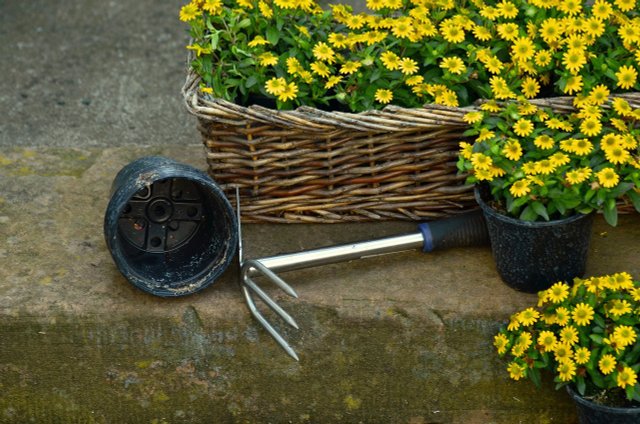
Flowers are especially good for beginning balcony gardeners. When buying, look for regional flowers. Thus, they are accustomed to the climate and better cope with repotting. Flowers on the balcony are not only beautiful to look at, but they are also bee-friendly plants at the same time.
These flowers are suitable:
- Vanilla flower
- Lavender
- Purslane
- Man’s chaff
- Convertible anemone
- Fan flower
With pre-grown flowers you can replant the balcony box two or three times a year, so you will always have beautiful flowers on the balcony.
Herbs for the balcony garden
Herbs are particularly suitable for a south and west facing balcony garden. When buying herbs, make sure they are grown locally and are organic. They are free of synthetic pesticides and you are supporting sustainable agriculture.
These herbs are suitable:
- Parsley
- Chives
- Basil
- Rosemary
- Thyme
- Marjoram
- Lemon balm
- Peppermint
- Herb pots you can grow very well on the wall or all herbs together in a large herb pot.
Balcony garden fruit

Most varieties of fruit require much more space than is available on the balcony. However, some species are suitable for growing fruit on the balcony and terrace.
Strawberries in particular are very popular with balcony gardeners. You can grow strawberries both in a balcony box and in a hanging basket. If you have more space available, trellis fruit is also suitable for growing on the balcony.
Vegetables for the balcony garden
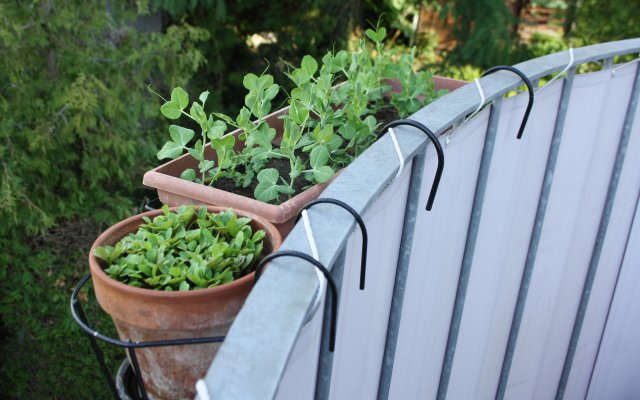
Especially if the balcony is protected from rainwater from above, it is perfect for growing tomatoes. Tomatoes do very well in large planters and thrive on south-facing balconies.
These vegetables do very well in large pots or in balcony planters:
- Tomatoes
- Peas
- Sugar snap peas
- Swiss chard
- Radishes
- Turnips
- Cucumbers
- Bell peppers
- Hot peppers
Lettuce for the balcony garden

Lettuce is one of the flat-rooted plants and is therefore particularly suitable for growing in trays and balcony boxes. Since lettuce does not tolerate so much heat, it is best to plant it on the west or east balcony. Choose pick-and-cut lettuces because they don’t form a head and you can harvest them over and over again by picking off the outer, mature leaves.
These varieties of lettuce are particularly suitable for growing on the balcony:
- Rocket (Wild Rocket)
- salad rocket
- Picking lettuce (Lollo Rosso, Lollo Biondo)
- Red and green oak leaf lettuce
- American brown
- Venetian brown
- Australian yellow
- Red salad bowl
- Baby Leaf Lettuce
Maintain balcony garden

Balcony garden requires much more care than a usual vegetable garden. This is due to the fact that the plants grow in pots, trays or balcony boxes and have no contact with the topsoil.
Watering
Planters can’t store water, so you’ll need to water the balcony garden regularly. Plants growing on a south-facing balcony need to be watered in the morning and evening in midsummer, as they lose a lot of water due to the strong sunlight.
Fertilize
Plants need a lot of nutrients. The soil in the planters is used up relatively quickly, especially if they are heavy growers such as tomatoes. It is therefore necessary that you regularly provide the potted plants on your balcony with supplementary nutrients. Fertilizing properly is essential for balcony vegetables, as the plants on the balcony have to make do with less substrate and therefore fewer nutrients. The fertilizer enriches the soil with minerals.
Proper dosage is important because each vegetable variety has different nutrient needs:
You must not fertilize seedlings and young plants. The high nutrient content hinders their growth and they die in the worst case.
From June onwards, fertilizing every 1-2 weeks is sufficient, depending on the variety.
Avoid over-fertilizing, this will damage the plants.
Despite fertilizing, you should change the soil in the balcony garden once a year.
Tip: On the balcony you can make your own fertilizer with a worm bin or a Bokashi bucket.
Pests in the balcony garden
Since the plants in the balcony garden are usually much denser than usual, pests spread particularly quickly. It is therefore important that you check the plants daily for pests when watering them.
You should isolate infested plants as soon as possible so that the pests cannot spread to other plants. Only when you have nursed the plant back to health, it may move back on the balcony.
Balcony garden winter
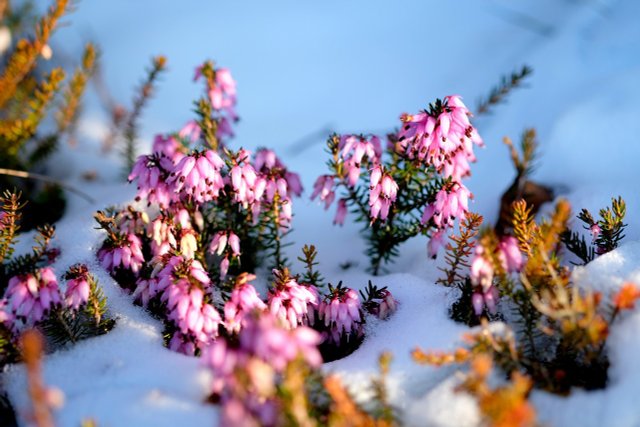
If you grow annuals in your balcony garden, winter is not a problem.
- Empty and clean the planters.
- Keep the pots and window boxes dry in the basement.
- If you are growing perennial hardy balcony plants, it doesn’t mean you can leave the pots on the balcony during the winter. The term “hardy” refers to the fact that the plant grows in topsoil and overwinters. Pots will freeze through very quickly in the winter and the plant will die.
Find winter quarters for your perennial plants in their pots.
If the plant needs winter rest, put it in a bright basement or cool conservatory.
You can overwinter all other plants on a bright windowsill indoors.
If you want to have a fourth season in the balcony garden, you need to plant suitable hardy plants for the winter balcony.









